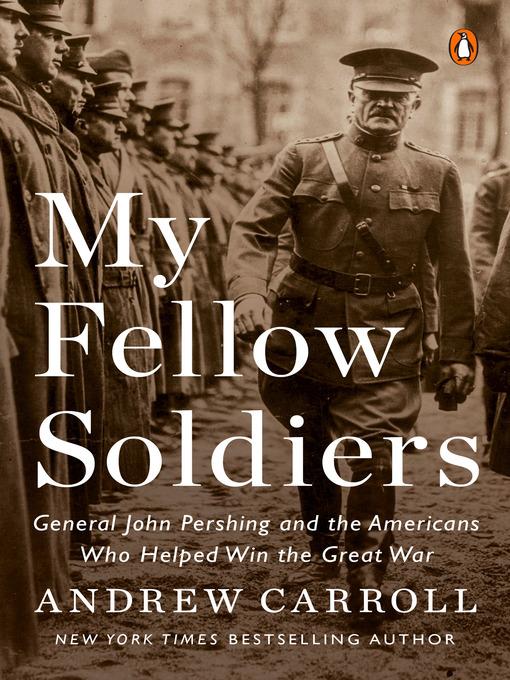
My Fellow Soldiers
General John Pershing and the Americans Who Helped Win the Great War
- اطلاعات
- نقد و بررسی
- دیدگاه کاربران
نقد و بررسی

February 20, 2017
Carroll (Here Is Where), creator of the Legacy Project war correspondence archives, leads readers through the WWI experience via personal correspondence from soldiers in the trenches. Selecting excerpts from thousands of letters to highlight the human perception of the war, Carroll embeds these recollections in a clear, chronological war narrative that takes the reader from the beginning of the war in 1914 through President Wilson’s decision to enter the war in 1917 and the U.S. military’s combat experience for the remainder of the conflict. Carroll uses the personal correspondence of Gen. Pershing, the U.S. commander in France, as a means of establishing the war timeline. Varied American perspectives of the war are included, and the letters of African-Americans and women figure prominently in the work. Experts on WWI may not find much new in this volume, but for those who are not familiar with the war or only know its broad outlines, Carroll has produced an engaging and informative introduction to a war that has been largely relegated to the shadows by the subsequent global conflagration. Agent: Miriam Altshuler, DeFiore and Company.

February 1, 2017
World War I as seen through the private writings of American participants.Using Gen. John Pershing (1860-1948), the commander of the American Expeditionary Force, as a centerpiece, Legacy Project founder and bestselling author Carroll (Here Is Where: Discovering America's Great Forgotten History, 2013, etc.) sets the ambitious task of telling "the story of the American experience in World War I...primarily through the letters, journals and other personal writings that Pershing and his countrymen wrote throughout the conflict." The narrative features an eclectic cast of characters. Some were leaders famous at the time--e.g., President Woodrow Wilson and Gen. Leonard Wood--while others became famous later, including George Patton, George Marshall, and Harry Truman. Most were humble individuals caught up in the war: ambulance drivers, fledgling aviators, an Army nurse, and soldiers in all-black regiments who found themselves used as stevedores or seconded to the French army once they were "over there." The personal anecdotes are engaging and well-told; the selected written materials, particularly the ones from the ordinary people, ring with a down-home authenticity and an earnest moral naivete impossible to imagine in 21st-century youth. However, even as Carroll limits his attention to writers directly connected to the war, his attempt to present the viewpoints of everyone from president to private, while putting it all in the context of the flow of events, necessarily restricts readers' contact with most individuals to little more than a superficial introduction. Nor are the source materials always particularly helpful. While Pershing's tender letters to his young son and to female companions (his wife had died in a fire) help to humanize a man who cultivated a stony public image, they do not illuminate his conduct of the war or his professional relations with others; rather, they seem to stand to one side as unexpected curiosities. A diverting view of some Americans' roles in this century-old conflict. For a more fine-grained focus on the ordinary man, see Peter Englund's The Beauty and the Sorrow (2012).
COPYRIGHT(2017) Kirkus Reviews, ALL RIGHTS RESERVED.

May 15, 2017
The title of Carroll's (founding director, Ctr. for American War Letters, Chapman Univ., CA; War Letters) latest book comes from a letter written by Gen. John Pershing (1860-1948) to every soldier in the American Expeditionary Forces at the end of World War I. This narrative history of America's actions in the Great War uses letters from pilots, doughboys, nurses, and ambulance drivers, including a recently discovered set written by Pershing. Through these firsthand accounts, readers gain a deeply personal and immediate picture of the battles and participants. While some names are recognizable, such as Gen. George S. Patton and Gen. Douglas MacArthur, many are not. These letters and diaries offer an intimate perspective on what it was like to drive ambulances with wooden seats over crater-ridden roads, as well as the daily experiences of nurse Alta May Andrews and her work in the "Jaw Ward," where the most devastating facial injuries were sent. A gentler and private side to Pershing is revealed through letters to his son, Warren, who survived a tragic event that took the lives of Pershing's wife and daughters. VERDICT Recommended for those interested in a personal account of America's involvement in the Great War. [See Prepub Alert, 10/17/16.]--Chad E. Statler, Lakeland Comm. Coll., Kirtland, OH
Copyright 2017 Library Journal, LLC Used with permission.




دیدگاه کاربران